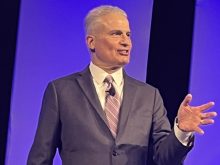Two very different pictures are painted in a side-by-side comparison of economic growth in the United States and Canada when it comes to household debt as a ratio to disposable income.
However, peering deeper into the numbers, it shows an American strength that is very fragile, especially when considering the discrepancy in that growth between the haves and have nots.
It also questions how smoothly the machine will run in the long term, especially with plenty of tariff uncertainty and far-reaching implications for the agriculture industry.
Read Also

Saskatchewan amends farm land ownership regulations
The Canada Pension Plan Investment Board can no longer own Saskatchewan farmland.
Growth in the U.S. has been strong, at approximately 2.8 per cent last year. A strong fourth quarter in Canada bumped things up from 1.3 to 1.6 per cent.
“That’s still not ideal, though,” said Christian Lawrence, a senior macro markets strategist with Rabobank.
“Canada should really be growing at around about a two per cent rate, so market slow down versus the U.S., very big divergence in those business cycles.”
During a presentation at the recent Alberta Beef Industry Conference in Calgary, Lawrence made some financial predictions for the upcoming year.
“If you look at GDP per capita, so you adjust for population growth, in Canada, we’ve had roughly seven out of the last quarters have been contractionary. Essentially, a lot of the overall growth in Canada has simply been about the population growth.”
He said economic growth in the U.S. is driven by the consumer. In fact, the U.S. dwarfs the other heavy hitters by a wide margin.
“If you think of household consumption on a global perspective, nearly a third of all global consumption happens in the U.S., more than China and Europe put together,” said Lawrence.
However, that economic driver is top heavy, he added.
A common economic theory says that as equities go up, house prices go up, people feel wealthier and they spend more. This does not hold true in many countries, but it does in the U.S.
Visa has estimated that 34 cents of every dollar worth of financial assets, including housing, was spent in 2022, compared to nine cents in 2017.
Household net worth has been rising rapidly in the U.S., but those numbers have been skewed by the most wealthy having a disproportionate effect. Lawrence presented a chart that started at the beginning of the COVID-19 pandemic in 2020 showing how much household liquid assets have increased.
“The top 20 per cent have been doing very nicely. The Wall Street Journal came out with a report, they estimate around 47 per cent of consumption in the U.S. has been driven by the top 10 per cent of households. The top one per cent of households in the U.S. own more equities than the bottom 50 per cent. So this is a story of really being boosted by those upper income households,” said Lawrence.
“The lower 2o per cent, you’ve had a bit of an improvement there recently, and that goes back to the point about wages now rising faster than inflation.”
However, lower income households have seen a rapidly rising rate of credit card delinquencies. It is not as high as it was in 2010, but that was the aftermath of the global financial crisis and is considered an outlier.
Looking at subprime auto loans in the U.S., delinquency rates are above 2007 levels.
“So there’s certainly cracks on the horizon. Those lower-income households have been using credit cards to borrow to try and keep up with that cost of living. We’ve seen recently a downturn in confidence, and a huge surge in inflation expectations in the U.S. This is really being driven by the policy uncertainty and tariffs. It’s stagflation by rising inflation and slowing growth. I think that is the concern for the U.S. this year,” said Lawrence.
“When I look at my GDP forecasts for Canada, I expect it to grow about 1.4 per cent this year. I should be clear here that is assuming the 25 per cent tariffs are off the table, and we see a more nuanced approach. In the U.S., though, we think growth will be about two per cent, so this divergence in terms of economic strength is going to continue now.”

















